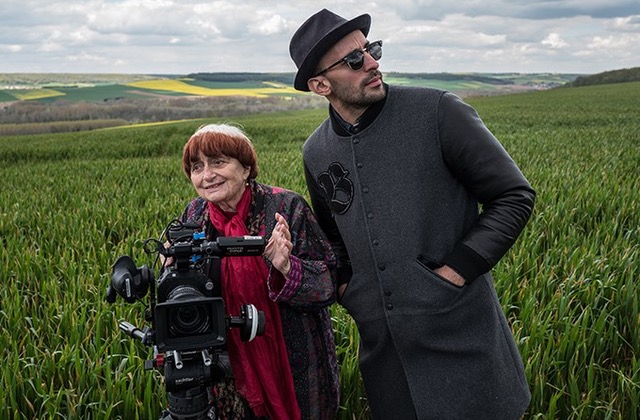Directors: Agnès Varda, JR,
Watched on: Netflix,
Rating: 2/5.
I loved Agnès Varda’s documentaries, The Beaches of Agnès and The Gleaners and I,for their unabashed reflexivity and casual wonder. She is an artist of the people, intertwining her off-hand interviews with melancholic asides on memory and the ever-shifting nature of relationships. Her best film, Vagabond, is a fictional narrative with documentary-like soundbites, set-up to look like the work of a reporter investigating the unsolved death of the titular young woman whose body is found in a ditch. The movie is uncompromising, even brutal, without the playfulness and wink she sometimes applies to her docs.
That playfulness, leavened by a profound seriousness in her own non-fiction work, is perhaps the reason why the French artist, who goes by the initials JR, wanted to make a film with her. It’s the whimsy that rules here, threatening and mostly succeeding in turning what may have looked like a good idea in pre-production into an often exasperating and lightweight throwaway. JR, with his hipster porkpie and lanky energy, drives around the countryside in a van outfitted as a mobile photo booth. He takes pictures of townspeople and curious tourists on the spot and then his van spits out giant, large-format black-and-whites on cheap paper, which JR’s crew then pastes on buildings, ruins, and–in one instance–shipping containers. He is one of those artists that other artists might loathe for believing himself to be a man of the people when really, he is just a man of the zeitgeist. His idea is superficially engaging while the results are instantly forgettable.
Varda is along for the ride, acting as another set of eyes and, it seems, as a foil for JR’s new art in contrast to Varda’s old, which also included photos, most of which are imbued with a depth that–based on the evidence in this film–JR may not be willing to match. They arrive in towns, chat up the locals, take sidetrips and photos, and eventually share moments of suspiciously scripted-sounding advice and philosophy.
There is already much in the film that is obviously staged, from the too-cute opening credits to the carefully composed conversational settings to the choreographed reaction shots. The comical poignancy of this meeting-of-the-generations road trip is undercut by a sustained and annoying sense that the overdetermined spontaneity is engineered for our benefit. One example: Varda narrates the delivery of a letter (a love letter, we are to think) to a young woman standing amid JR’s towering, wall-plastered pictures. A postman arrives on a bicycle and, sure enough, he pulls out a letter, a large white cutout “E.”
These moments, along with a string of insufferable scene-ending punctuation shots, made me suspect the veracity of the final section of the movie, when Varda visits the home of her old friend, Jean-Luc Godard. I’d been enduring the whole film for this moment but–spoiler alert–Godard stands her up. Did they know this all along? Was the whole scene manufactured, right down to the note Godard scrawled on the glass door of his house? I don’t want to think so, but this is what happens when you insert staged encounters and actorly poses into a documentary. When the real stuff happens, you can’t quite ever trust it.
Faces Places is really nothing more than what the title suggests, which is one reason why it was nominated for a Best Documentary Oscar, the ultimate signifier of a film’s facile servitude to demographic popularity.

